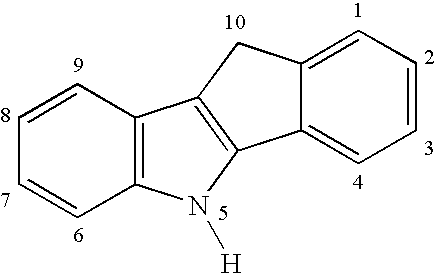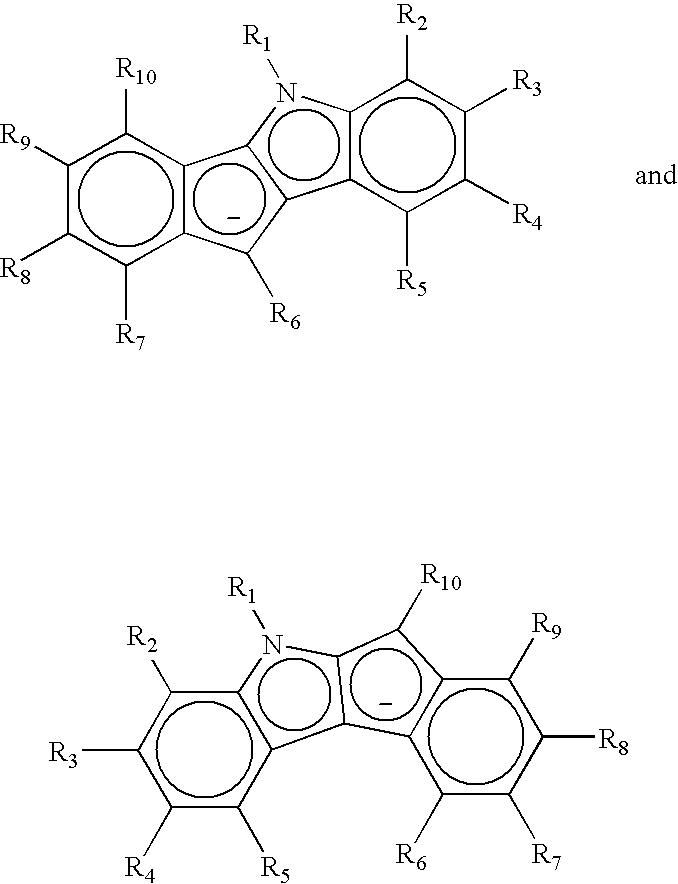Preparation of multimodal polyethylene
a polyethylene and polyethylene technology, applied in the field of polyethylene preparation, can solve the problems of reducing the thermal processability of single-site polyethylene, limiting the development of single-site polyethylene, and difficult processing of single-site polyethylene under the conditions, and achieve the effect of improving processability
- Summary
- Abstract
- Description
- Claims
- Application Information
AI Technical Summary
Benefits of technology
Problems solved by technology
Method used
Image
Examples
example 1
Preparation of a Bridged Indenoindolyl Catalyst: Dimethylsilyl-Bridged Indeno[1,2-B]Indolyl Cyclopentadienyl Zirconium Dichloride
(a) Preparation of Indeno[1,2-b]indole
[0051] A mixture of 1-indanone (30.6 g, 232 mmol) and p-tolylhydrazine hydrochloride (37.0 g, 233 mmol) in EtOH (350 mL) and aqueous HCl (12 N, 18 mL) are heated to reflux for 90 min. The mixture is cooled and filtered, and the solid is washed with EtOH (600 mL) followed by 20% aqueous EtOH (400 mL) and finally hexanes (200 mL). The off-white solid is dried under vacuum (36.5 g, 72%).
(b) N-Methylation
[0052] A mixture of product (a) (36.5 g, 166 mmol), aqueous NaOH solution (112 mL, 20 M, 2.2 mol), C16H33NMe3Br (0.65 g, 1.78 mmol), and toluene (112 mL) is vigorously stirred at room temperature. A solution of Mel (17.0 mL, 273 mmol) in toluene (15 mL) is added dropwise, and the mixture is stirred at room temperature for 4 h and refluxed for 3 h. A crystalline solid forms upon cooling and is filtered and washed with...
example 2
Preparation of an Non-Bridge Indenoundolyl Catalyst: Indeno[1,2-B]Indolyl Cyclopentadienyl Zirconium Dichloride
[0057] In a glovebox under nitrogen, N-methylated indeno[1,2-b]indole (14.2 g, 60.9 mmol), prepared as described in Example 1, is dissolved in toluene (175 mL). n-Butyllithium (38.0 mL of 2.5 M solution in hexanes, 95 mmol) is added carefully under vigorous stirring at room temperature to give a red solution. After one hour, a precipitate forms. The mixture is kept at room temperature overnight and is then filtered and washed with toluene (100 mL) and then heptane (200 mL). The sticky product is dried under nitrogen in the glovebox and is collected and dried under vacuum.
[0058] A sample of the indeno[1,2-b]indolyl lithium salt produced above (10 g, 42 mmol) is dissolved in toluene (95 mL) to produce an orange slurry. Diethyl ether (35 mL) is added slowly to give an orange solution. This solution is added over 15 min. at room temperature with stirring to a slurry of cyclo...
example 3
Preparation of Silica-Supported, Mixed Bridged and Non-Bridged Indenoindolyl Catalysts
[0059] Silica (Fuji G-3) is calcined for 16 h at 200° C. Methylalumoxane (2.4 mL of 1.4 M solution of MAO in toluene, product of Albemarle) is added to a 12 g-sample of the calcined silica in 50 mL of toluene, and the mixture is stirred at ambient temperature for 1 h and then at 100° C. for 2 h. The bridged catalyst from Example 1 (0.27 g) and the non-bridged catalyst from Example 2 (0.27 g) and MAO solution (14 mL) are mixed. The mixture is dissolved in toluene (30 mL). The solution is added to the pretreated silica. Removal of volatiles gives a free-flowing powder used in the polymerization step.
PUM
| Property | Measurement | Unit |
|---|---|---|
| molecular weight distribution | aaaaa | aaaaa |
| density | aaaaa | aaaaa |
| density | aaaaa | aaaaa |
Abstract
Description
Claims
Application Information
 Login to View More
Login to View More - R&D
- Intellectual Property
- Life Sciences
- Materials
- Tech Scout
- Unparalleled Data Quality
- Higher Quality Content
- 60% Fewer Hallucinations
Browse by: Latest US Patents, China's latest patents, Technical Efficacy Thesaurus, Application Domain, Technology Topic, Popular Technical Reports.
© 2025 PatSnap. All rights reserved.Legal|Privacy policy|Modern Slavery Act Transparency Statement|Sitemap|About US| Contact US: help@patsnap.com



